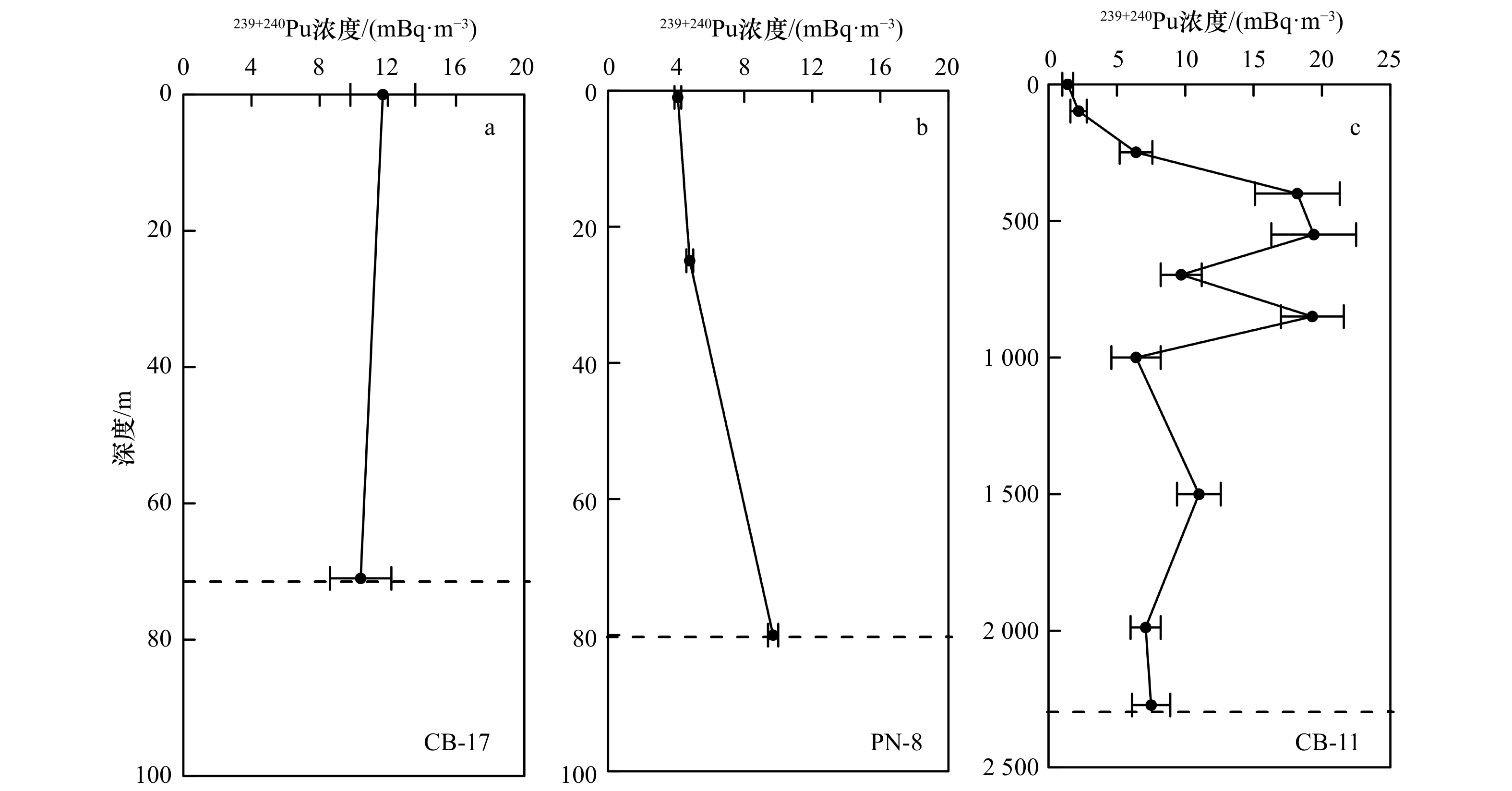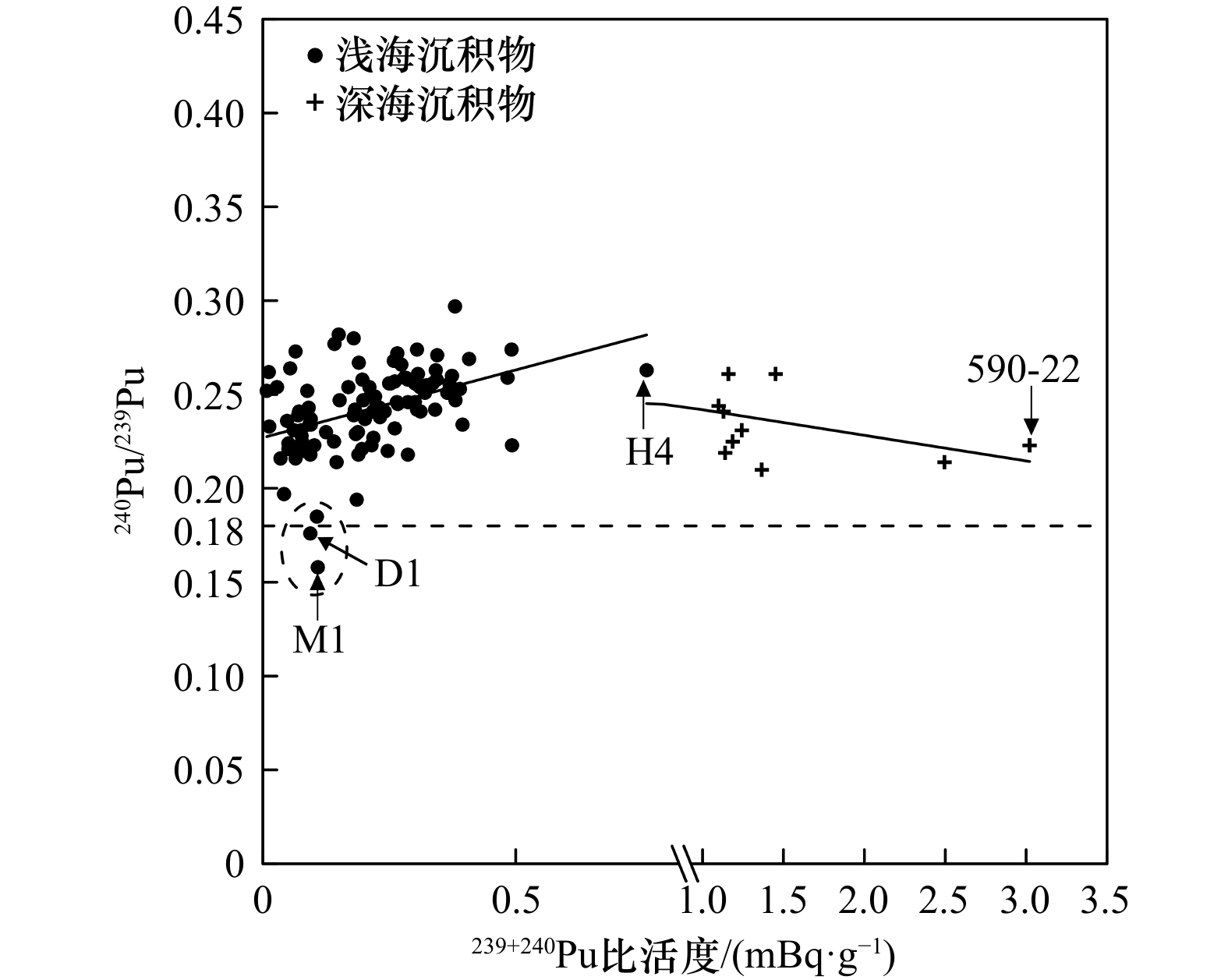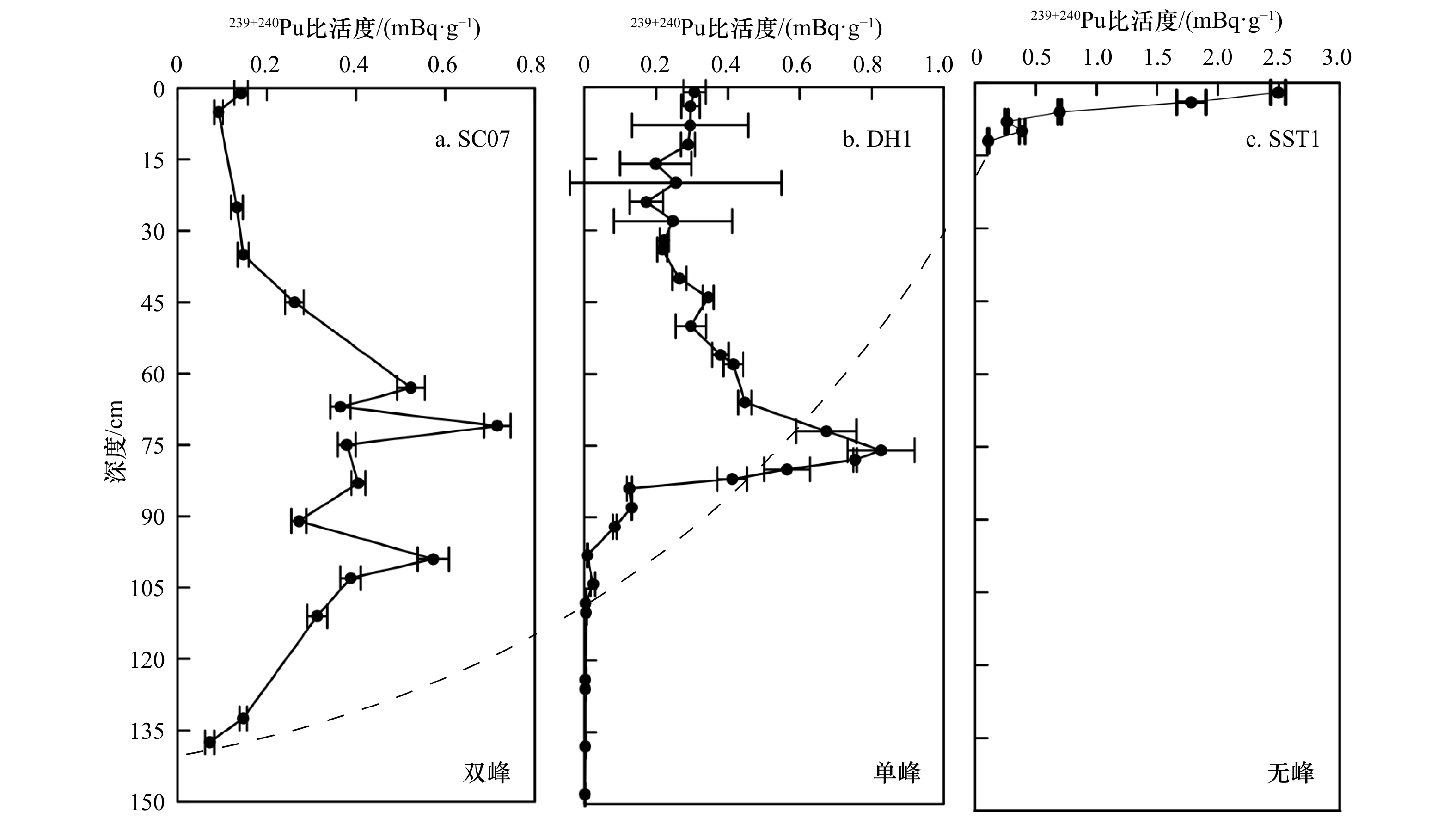Source and sedimentary process of 239+240Pu in the eastern China seas
-
摘要: 本文对东海及毗邻海域中239+240Pu比活度、240Pu/239Pu原子比值和239+240Pu累积通量或沉积通量数据进行整理,首次从大气沉降、海水中、生物体中、沉积物捕获器中以及沉积物中的239+240Pu 5个方面阐述了东海及毗邻海域中239+240Pu的地球化学行为。研究结果表明,全球大气沉降和太平洋核试验场输入的239+240Pu是东海海水和沉积物中239+240Pu的两个主要来源;在长江径流、浙闽沿岸流、台湾暖流、黑潮与上升流等水团的混合作用以及清除作用的影响下,东海近岸海水中239+240Pu浓度在时间上呈现被清除而减少的趋势,相应近岸浅水区沉积物中239+240Pu的埋藏深度高于远岸深水海域。在黑潮入侵和上升流的作用下,冲绳海槽区尤其是台湾岛东北部,沉积物中的239+240Pu比活度与沉积通量显著增大。同时,利用东海表层沉积物中239+240Pu比活度和240Pu/239Pu原子比值的相关关系证实了台湾东北部黑潮底层分支流的存在,并指示出台湾暖流与黑潮底层分支流可能交汇的海域位置。
-
关键词:
- 239+240Pu /
- 240Pu/239Pu /
- 东海 /
- 沉积物 /
- 海水
Abstract: This study compiled the data of 239+240Pu specific activity, 240Pu/239Pu atom ratio and 239+240Pu flux or inventory in the East China Sea and adjacent waters. Based on the 239+240Pu concentration in atmospheric fallout, 239+240Pu in seawater, 239+240Pu in organisms, 239+240Pu in sediment trap and 239+240Pu in sediment, the geochemical behavior of 239+240Pu were explained in the East China Sea and adjacent waters. The results showed that global fallout and Pacific proving grounds close-in fallout were the two major sources of 239+240Pu. Under the influence of water masses such as the Changjing River diluted water, Zhejiang-Fujian Coastal Current, Taiwan Warm Current, Kuroshio Current and upwelling current, mixing effect and removal effect, the concentration of 239+240Pu in coastal waters of the East China Sea showed a trend of removal over time, the burial depth of 239+240Pu in the near shore sediments was deeper than that in the far sea area. In the northeast of Taiwan Island of China, the 239+240Pu specific activity and 239+240Pu inventory in Okinawa Trough increased significantly under the influence of Kuroshio current intrusion and upwelling current. At the same time, this study found that the relationship between 239+240Pu specific activity and 240Pu/239Pu atom ratio in surface sediments of the East China Sea, and confirmed the existence of a tributary of the Kuroshio bottom in northeastern Taiwan, and indicated the location where the Taiwan Warm Current and a tributary of the Kuroshio bottom may intersect.-
Key words:
- 239+240Pu /
- 240Pu/239Pu /
- East China Sea /
- sediment /
- seawater
-
表 1 东海及毗邻区239+240Pu样品的数据信息
Tab. 1 Data information about 239+240Pu samples in the East China Sea and adjacent waters
序号 239+240Pu样品类型 个数 测定方法 标样验证 采样时间 参考资料 1 海水(表层) 10* α能谱 n.a. 1981年 文献[6] 2 沉积物(表层)+海水(表层) 31 α能谱 n.a. 1971–1996年 MARIS 3 海水(柱样)+沉积物(柱样) 10 α能谱 n.a. 1987年前后 文献[7−8] 4 沉积物(柱样) 22 α能谱 IAEA-SD-N-1 1998年之前 文献[2] 5 悬浮颗粒物+沉积物(柱样) 5 α能谱 n.a. 1991年11月 文献[9] 6 沉积物(柱样) 34 α能谱 IAEA-SD-N-1 1996–1999年 文献[10] 7 生物体(中华哲水蚤) 1 α能谱 n.a. 1993–1996年 文献[11] 8 海水(表层) 22 α能谱 n.a. 1993–1996年 文献[1] 9 海水(柱样) 3 α能谱 n.a. 1993年10月 文献[12] 10 海水(表层) 16 α能谱 n.a. 1993–1994年 文献[13] 11 沉积物(柱样) 6 ICP-MS IAEA-133A,327,375 2000–2003年 文献[14] 12 沉积物(柱样) 6 ICP-MS IAEA-368 1992–1995年 文献[15] 13 沉积物(柱样) 1 AMS colAMS 2006年4月 文献[16] 14 沉积物(表层样+柱样) 21 SF-ICP-MS IAEA-368 2006年4月 文献[17] 15 沉积物(表层样+柱样) 29 ICP-MS X-II IAEA-376 2013年8月 文献[18] 16 海水(表层) 7 ICP-MS IAEA-384,395,443 2011年,2014–2015年 文献[19] 17 沉积物(表层样+柱样) 48 SF-ICP-MS IAEA-368 2013–2015年 文献[20] 18 沉积物(表层样) 8 SF-ICP-MS IAEA-368 2019年之前 文献[21] 注:*表示每个站位有2个平行样取平均值;n.a.表示从原文中无法获得;( )内表示具体的样品类型;MARIS表示海洋放射性核素信息系统(Marine Radioactivity Information System),参见https://maris.iaea.org/。 -
[1] Lee S H, Gastaud J, Povinec P P, et al. Distribution of plutonium and americium in the marginal seas of the Northwest Pacific Ocean[J]. Deep-Sea Research Part II: Topical Studies in Oceanography, 2003, 50(17/21): 2727−2750. [2] Huh C A, Su C C. Sedimentation dynamics in the East China Sea elucidated from 210Pb, 137Cs and 239+240Pu[J]. Marine Geology, 1999, 160(1/2): 183−196. [3] 王建丰, 司广成, 于非. 台湾暖流变化特征及机制研究进展[J]. 海洋科学, 2020, 44(5): 141−148.Wang Jianfeng, Si Guangcheng, Yu Fei. Progress in studies of the characteristics and mechanisms of variations in the Taiwan warm current[J]. Marine Sciences, 2020, 44(5): 141−148. [4] UNSCEAR. Sources, effects of ionizing radiation[M]//Unscear. Report to the General Assembly with Annex B. New York: United Nations, 2000. [5] 黄亚楠, 潘少明. 中国边缘海柱样沉积物中239+240Pu的分布与时标价值[J]. 中国环境科学, 2020, 40(3): 1235−1245. doi: 10.3969/j.issn.1000-6923.2020.03.035Huang Ya’nan, Pan Shaoming. The dating and distribution of 239+240Pu in the sediment cores of the marginal sea of China[J]. China Environmental Science, 2020, 40(3): 1235−1245. doi: 10.3969/j.issn.1000-6923.2020.03.035 [6] 李培泉, 颜启民, 于银亭. 冲绳海槽及东海表层海水中超铀元素钚的测定[J]. 海洋科学, 1988(3): 43−46.Li Peiquan, Yan Qimin, Yu Yinting. The determination of plutonium in surface seawater of Okinawa Trough and East China Sea[J]. Marine Sciences, 1988(3): 43−46. [7] Nagaya Y, Nakamura K. 239, 240Pu and 137Cs in the East China and the Yellow Seas[J]. Journal of Oceanography, 1992, 48(1): 23−35. doi: 10.1007/BF02234030 [8] Yamada M, Zheng Jian. Determination of 240Pu/239Pu atom ratio in seawaters from the East China Sea[J]. Radiation Protection Dosimetry, 2011, 146(1/3): 311−313. [9] Yamada M, Aono T. Large particle flux of 239+240Pu on the continental margin of the East China Sea[J]. Science of the Total Environment, 2002, 287(1/2): 97−105. [10] Su C C, Huh C A. 210Pb, 137Cs and 239, 240Pu in East China Sea sediments: sources, pathways and budgets of sediments and radionuclides[J]. Marine Geology, 2002, 183(1/4): 163−178. [11] Hong G H, Kim Y I, Lee S H, et al. 239+240Pu and 137Cs concentrations for zooplankton and nekton in the Northwest Pacific and Antarctic Oceans (1993−1996)[J]. Marine Pollution Bulletin, 2002, 44(7): 660−665. doi: 10.1016/S0025-326X(01)00322-8 [12] Yamada M, Aono T. Vertical profiles of 239+240Pu in seawater from the East China Sea[J]. Journal of Radioanalytical and Nuclear Chemistry, 2003, 256(3): 399−402. doi: 10.1023/A:1024579111492 [13] Hong G H, Chung C S, Lee S H, et al. Artificial radionuclides in the Yellow Sea: Inputs and redistribution[J]. Radioactivity in the Environment, 2006, 8: 96−133. [14] Lee S Y, Huh C A, Su C C, et al. Sedimentation in the southern Okinawa Trough: enhanced particle scavenging and teleconnection between the Equatorial Pacific and western Pacific margins[J]. Deep-Sea Research Part I: Oceanographic Research Papers, 2004, 51(11): 1769−1780. doi: 10.1016/j.dsr.2004.07.008 [15] Wang Zhongliang, Yamada M. Plutonium activities and 240Pu/239Pu atom ratios in sediment cores from the East China Sea and Okinawa Trough: sources and inventories[J]. Earth and Planetary Science Letters, 2005, 233(3/4): 441−453. [16] Tims S G, Pan Shaoming, Zhang R, et al. Plutonium AMS measurements in Yangtze River Estuary sediment[J]. Nuclear Instruments and Methods in Physics Research Section B: Beam Interactions with Materials and Atoms, 2010, 268(7/8): 1155−1158. [17] Liu Zhiyong, Zheng Jian, Pan Shaoming, et al. Pu and 137Cs in the Yangtze River Estuary sediments: distribution and source identification[J]. Environmental Science & Technology, 2011, 45(5): 1805−1811. [18] Wang Jinlong, Baskaran M, Hou Xiaolin, et al. Historical changes in 239Pu and 240Pu sources in sedimentary records in the East China Sea: implications for provenance and transportation[J]. Earth and Planetary Science Letters, 2017, 466: 32−42. doi: 10.1016/j.jpgl.2017.03.005 [19] Wu Junwen. Sources and scavenging of plutonium in the East China Sea[J]. Marine Pollution Bulletin, 2018, 135: 808−818. doi: 10.1016/j.marpolbul.2018.08.014 [20] Zhang Rui, Wang Ruirui, Liu Zhiyong, et al. Distribution and transport of plutonium in the sediments of the Yangtze River Estuary and the adjacent East China Sea[J]. Applied Geochemistry, 2020, 115: 104532. doi: 10.1016/j.apgeochem.2020.104532 [21] Liu Zhiyong, Hu Jun, Yamada M, et al. Uranium and plutonium isotopes and their environmental implications in surface sediments from the Yangtze River catchment and estuary[J]. Catena, 2020, 193: 104605. doi: 10.1016/j.catena.2020.104605 [22] Thakur P, Khaing H, Salminen-Paatero S. Plutonium in the atmosphere: a global perspective[J]. Journal of Environmental Radioactivity, 2017, 175−176: 39−51. doi: 10.1016/j.jenvrad.2017.04.008 [23] 张克新, 潘少明, 徐仪红, 等. 长江口放射性核素Pu的大气湿沉降初步研究[J]. 地理科学, 2016, 36(1): 157−160. doi: 10.13249/j.cnki.sgs.2016.01.020Zhang Kexin, Pan Shaoming, Xu Yihong, et al. Atmospheric wet deposition of radionuclide Pu in the Changjiang River Estuary region[J]. Scientia Geographica Sinica, 2016, 36(1): 157−160. doi: 10.13249/j.cnki.sgs.2016.01.020 [24] Yamada M, Zheng Jian. 240Pu/239Pu atom ratios in water columns from the North Pacific Ocean and Bering Sea: transport of Pacific proving grounds-derived Pu by ocean currents[J]. Science of the Total Environment, 2020, 718: 137362. doi: 10.1016/j.scitotenv.2020.137362 [25] Wu Junwen, Dai Minhan, Xu Yi, et al. Sources and accumulation of plutonium in a large western Pacific marginal sea: the South China Sea[J]. Science of the Total Environment, 2018, 610−611: 200−211. doi: 10.1016/j.scitotenv.2017.07.226 [26] Imai T, Sakanoue M. Content of plutonium, thorium and protactinium in sea water and recent coral in the North Pacific[J]. Journal of the Oceanographical Society of Japan, 1973, 29(2): 76−82. [27] Buesseler K O. The isotopic signature of fallout plutonium in the North Pacific[J]. Journal of Environmental Radioactivity, 1997, 36(1): 69−83. doi: 10.1016/S0265-931X(96)00071-9 [28] Folsom T R. Several measurements of global radioactive fallout-speculation of the characteristics of the North Pacific that control the rate of dispersion of certain surface pollutants[J]. Isotope Ocean Chemistry, 1990: 30−72. [29] Yamada M, Aono T. 238U, Th isotopes, 210Pb and 239+240Pu in settling particles on the continental margin of the East China Sea: fluxes and particle transport processes[J]. Marine Geology, 2006, 227(1/2): 1−12. [30] 黄亚楠, 潘少明, 刘志勇. 中国边缘海沉积物中239+240Pu 的来源与存量模型[J]. 地理科学, 2018, 38(11): 1892−1903.Huang Ya’nan, Pan Shaoming, Liu Zhiyong. The source and inventory model of in the sediment cores of the marginal sea of China[J]. Scientia Geographica Sinica, 2018, 38(11): 1892−1903. [31] Yang Dezhou, Yin B aoshu, Liu Zhiliang, et al. Numerical study of the ocean circulation on the East China Sea shelf and a Kuroshio bottom branch northeast of Taiwan in Summer[J]. Journal of Geophysical Research Atmospheres, 2011, 116(C5): C05015. [32] 李安春, 张凯棣. 东海内陆架泥质沉积体研究进展[J]. 海洋与湖沼, 2020, 51(4): 705−727. doi: 10.11693/hyhz20200500145Li Anchun, Zhang Kaidi. Research progress of mud wedge in the inner continental shelf of the East China Sea[J]. Oceanologia et Limnologia Sinica, 2020, 51(4): 705−727. doi: 10.11693/hyhz20200500145 [33] Pittauer D, Roos P, Qiao Jixin, et al. Pacific proving grounds radioisotope imprint in the Philippine Sea sediments[J]. Journal of Environmental Radioactivity, 2018, 186: 131−141. doi: 10.1016/j.jenvrad.2017.06.021 [34] Huang Ya’nan, Sun Xiaoming, Zhang Wei, et al. Spatial distribution and migration of 239+240Pu in Chinese soils[J]. Science of the Total Environment, 2022, 824: 153724. doi: 10.1016/j.scitotenv.2022.153724 -





 下载:
下载:







